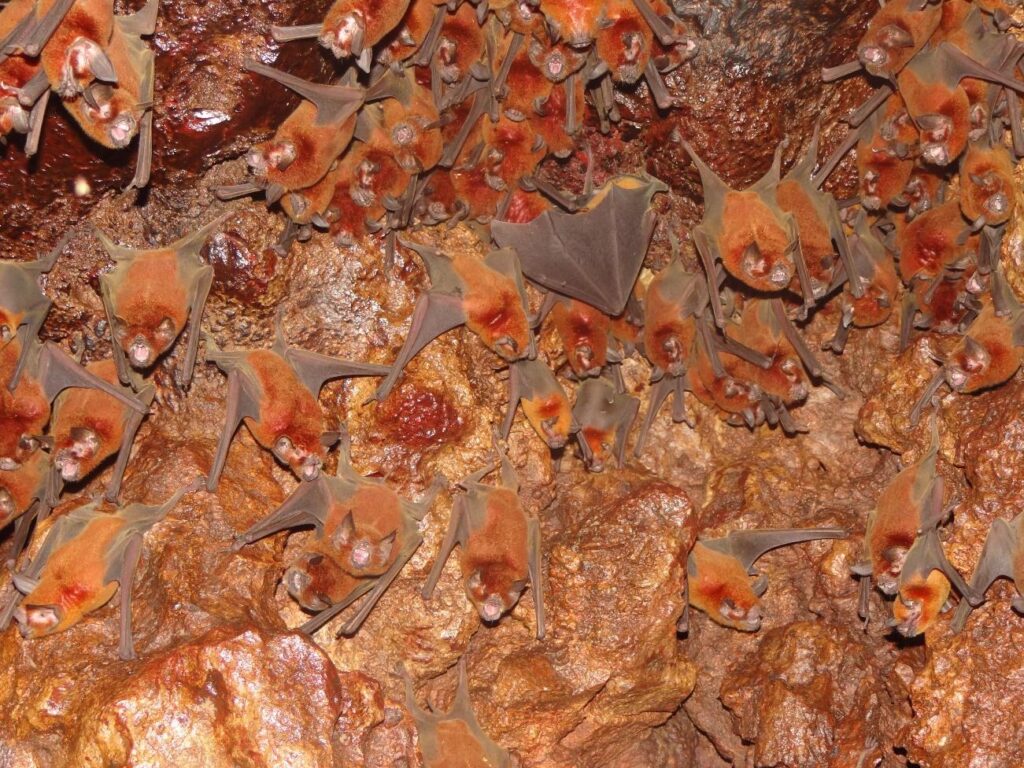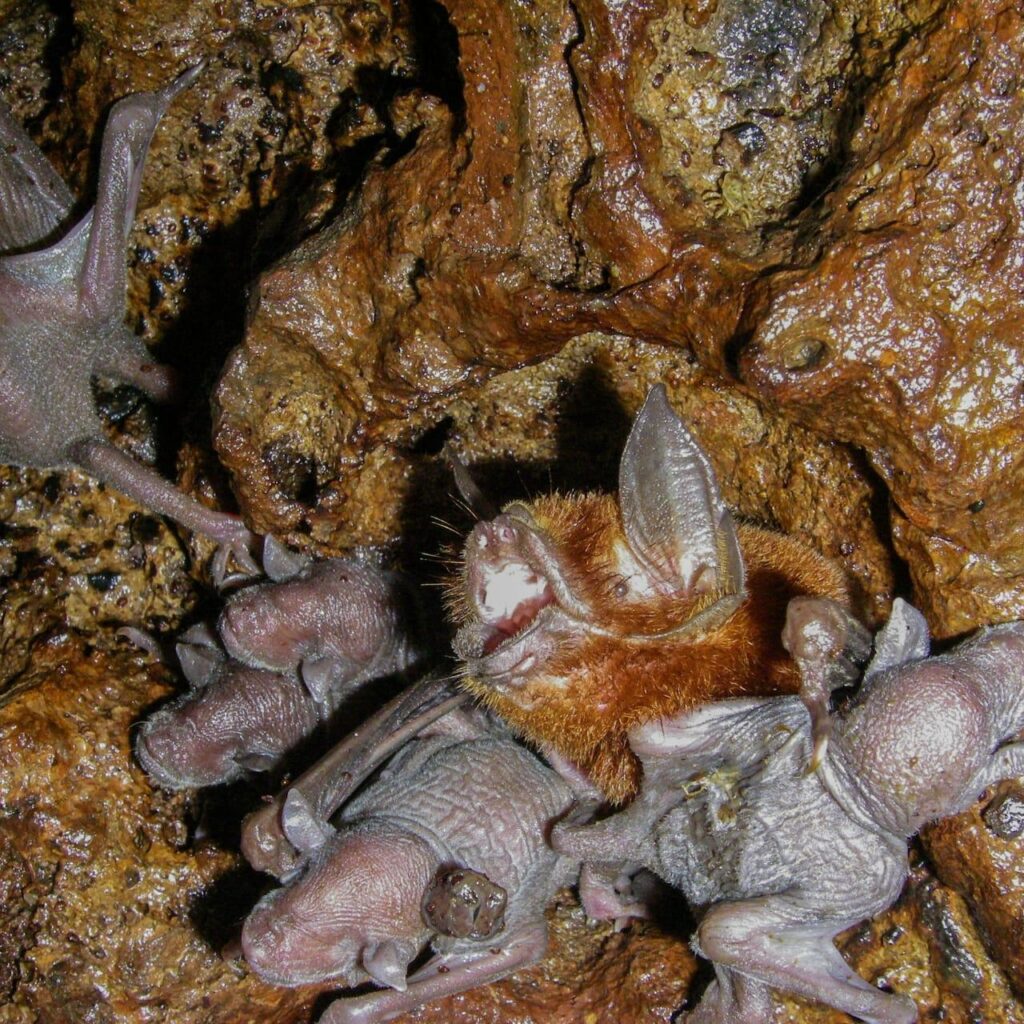Pteronotus rubiginosus is a bat belonging to the Mormoopidae Saussure family, in 1860. Currently in Brazil, three species of the genus Pteronotus have already been observed using caves as shelter, namely; Pteronotus personatus (Wagner, 1843), Pteronotus gymnonotus (Wagner, 1843) and Pteronotus rubiginosus (PAVAN, 2016). These species have distinct foraging behavior characteristics, a fact that makes it possible for them to live together in the same area or cave (PEREIRA; REIS; TAVARES, 2022).
The International Cave Animal of the Year chosen for Brazil, Pteronotus rubiginosus is widely distributed in the Neotropics occurring in Mexico, Venezuela, Cuba, Jamaica, Puerto Rico, Hispaniola, Saint Vincent, Trinidad and Tobago, Haiti, Guianas, Peru, Bolivia and Brazil, where it has already been observed in the states of Amazonas, Ceará, Goiás, Mato Grosso, Mato Grosso do Sul, Pará, Piauí, Rondônia, Roraima, and Distrito Federal.
Pteronotus rubiginosus is the largest species of the family, has small eyes, and expanded and ornate lips with the presence of thick hair around the upper lip, which resembles a mustache. For this reason, it is popularly known as the “mustache bat”. Its insectivorous diet is based mainly on the consumption of lepidopterans and coleoptera.
Pteronotus rubiginosus has gregarious behavior in some cases forming substantial populations, ranging from tens of thousands to millions of individuals. The caves that house these large populations are called bat caves and, in some cases, they can also be called hot caves when such caves have higher temperatures due to the body heat radiated by the colonies formed by tens of thousands of bats. Large populations of bats are extremely important, as they provide important ecosystem services by acting in pollination, seed dispersal of various plants, biological control of insects (including some considered agricultural pests), and contribute significantly to the energy supply in caves (PIMENTEL et al., 2022).
Bats of the genus Pteronotus have an insectivorous feeding habit and can consume a large number of insects in a single night. Recent studies show that a single individual can consume up to 28% of their body weight in insects in the same night, that is, about 2 grams per bat. This volume, when extrapolated to large colonies, can reach tons of insects consumed in a few days, therefore, an important biological agent in the control of pests and disease vectors, performing an important ecosystem service (PIMENTEL et al., 2022).

Foto: Daniela Pedrosa

Foto: Daniela Pedrosa
Bibliography
BARROS, JENNIFER DE SOUSA; BERNARD, Enrico; FERREIRA, RODRIGO LOPES. Ecological preferences of neotropical cave bats in roost site selection and their implications for conservation. Basic and Applied Ecology, v. 45, p. 31-41, 2020.
BRASIL. Ministério do Meio Ambiente. Portaria n. 148, de 07 de junho de 2022. Lista Nacional Oficial de Espécies da Fauna Ameaçadas de Extinção. Diário Oficial [da] República Federativa do Brasil, Poder Executivo, Brasília, DF, Seção 1, p. 74, 08 de junho de 2022. Disponível em: https://www.in.gov.br/en/web/dou/-/portaria-mma-n-148-de-7-de-junho-de-2022-406272733.
GARBINO, G.S.T., R. GREGORIN, I.P. LIMA, L. LOUREIRO, L.M. MORAS, R. MORATELLI, M.R. NOGUEIRA, A.C. PAVAN, V.C. TAVARES, M.C. DO NASCIMENTO AND A.L. PERACCHI. 2020. Updated checklist of Brazilian bats: versão 2020. Comitê da Lista de Morcegos do Brasil—CLMB. Sociedade Brasileira para o Estudo de Quirópteros (Sbeq).https://www.sbeq.net/lista-de-especies acessado em: 4 Mai. 2022.
KUNZ, T. H. Roosting ecology of bats. In: KUNZ, T.H. (Ed.). Ecology of bats. Boston. New York: Plenum Publishing Corporation, p.1-55, 1982.
PAVAN, A. C. & MARROIG, G. 2016. Integrating multiple evidences in taxonomy: species diversity and phylogeny of mustached bats (Mormoopidae: Pteronotus). Molecular Phylogenetics and Evolution, 103: 184–198.
PEREIRA, M. S. R.; REIS, A. S.; TAVARES, V. C. Morcegos. In: ZAMPAULO, R. A.; PROUS, X. (eds.) Fauna Cavernícola do Brasil. Belo Horizonte, Rupestre, 2022, p. 546-569.
PILÓ, L.B; CALUX, A. S.; SCHERER, R. S.; BERNARD, E. Bats as ecosystem engineers in iron ore caves in the Carajás National Forest, Brazilian. Disponível em: https://www.biorxiv.org/content/10.1101/2022.04.19.488750v1.full.
PIMENTEL, N. T., ROCHA, P. A., PEDROSO, M. A. & BERNARD, E., 2022, Estimates of insect consumption and guano input in bat caves in Brazil, Mammal Research, https://doi.org/10.1007/s13364-022-00629-3
REIS, N. R.; PERACCHI, A. L.; PEDRO, W. A.; LIMA, I. P. Morcegos dos Brasil. Londrina, PR: [s.n.], 2007. 256 p.
RUSCHI, A. Os morcegos das grutas do Limoeiro em Castelo, Monte Líbano em Cachoeiro do Itapemirim e de Itaúnas, em Morro d’Anta, em Conceição da Barra. Grutas de Inverno, Verão e Acidentais. Coabitação. O banho. Morcegário e criação em cativeiro. Pesquisas sobre Corpúsculos de Negri. Boletim do Museu de Biologia Prof. Mello-Leitão, [s.l.], n. 9 A, p. 1-88, 1952.
TORQUETTI, C. G.; SILVA, M. X.; TALAMONI, S. A. Differences between caves with and without bats in a Brazilian Karst habitat. Zoologia, An international Journal for Zoology. v.34, p.1-7, 2017.


















